
Robert Zimmerman was born in Minnesota in 1941, renaming himself Bob Dylan after Welsh poet Dylan Thomas. Dylan started his musical career dabbling in rock and roll, and saw Buddy Holly perform three days before Holly’s death. He shifted his interest to American folk music while at university, finding early rock and roll too facile. In 1961 he dropped out of university and travelled to New York City to meet his idol Woody Guthrie, ill with Huntington’s Disease. Dylan started playing in Greenwich Village cafes, launching an iconoclastic career that influenced the course of popular music.
Introduction
Bob Dylan started his recording career as a folk singer but refused to be pigeonholed. After establishing himself as a protest singer, he moved towards full band arrangements by the mid-1960s, infusing the rock and roll that he’d rejected earlier with his interest in poetry. After 1966’s magnum opus Blonde on Blonde he retreated from the limelight, and his output became less consistent, but he made some excellent albums in the late 1960s and 1970s as well. I’m covered most of his albums from the 1960s and 1970s, but only have a couple of his subsequent records. I also thoroughly enjoyed his autobiographical excerpts on Chronicles: Volume One. Dylan’s also released an excellent series of official “Bootlegs” – I’ve only covered one here, but I imagine several more are worth examining.
Like The Beatles, Dylan’s been so well covered that the world doesn’t really need my thoughts on him, but I’m writing about him because this site would feel incomplete without him – he’s one of the key artists of the rock music era, and it’s difficult to overstate his influence or the excellence of his catalogue.
Bob Dylan Album Reviews
Favourite Album: The Bootleg Series Vol. 4: Bob Dylan Live 1966, The “Royal Albert Hall” Concert
Overlooked Gem: New Morning
Bob Dylan
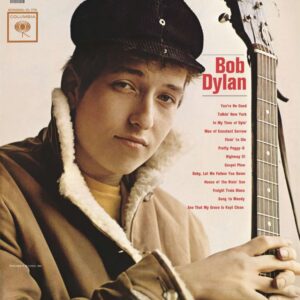
1962, 7/10
Dylan was invited to play harmonica on a recording session by folk singer Carolyn Hester, where he was signed to his own record deal by Columbia Records talent scout and producer John Hammond. Surprisingly, given that he’s known as a preeminent songwriter, Bob Dylan’s first album is comprised almost entirely of covers. It’s a personality-driven record, and Bob Dylan’s charismatic and braying vocals are intriguing. Only four of these songs were drawn from Dylan’s live set at the time so that the album serves as a summary of the early 1960s New York folk scene – Dylan used arrangements devised by contemporaries like Dave Van Ronk and Eric Von Schmidt.
Even if you think of early Dylan as a folk artist, many of these songs are blues-based – Led Zeppelin later stretched out ‘In My Time Of Dying’ into an epic, while the album ends with Blind Lemon Jefferson’s ‘See That My Grave Is Kept Clean’. The two original songs here show Woody Guthrie’s influence – ‘Talkin’ New York’ is in Guthrie’s style, while ‘Song For Woody’ is a lovely tribute piece that’s one of Dylan’s most unguarded moments.
It’s essentially a false start to Dylan’s career, not preparing listeners what was to come with his phenomenal second album, but Bob Dylan is an enjoyable, albeit minor work.
The Freewheelin’ Bob Dylan

1963, 9.5/10
Dylan’s first album failed to make an impact, and producer John Hammond was determined that the second album would succeed. Perhaps shaped by the parents of girlfriend (and cover companion) Suze Rotolo, who were members of the American Communist Party, Dylan peeled off an astonishing number of phenomenal original songs. Early Dylan is known as a protest singer, and some of the most notable songs here are in that vein – the anti-war and universal ‘Blowin’ In The Wind’ is early Dylan’s signature song, and was his breakthrough piece, thanks to Peter, Paul, and Mary’s version. But he’s hardly a po-faced protest singer here, balancing the ultra-serious material like ‘Masters of War’ with fun songs like ‘Honey, Just Allow Me One More Chance’.
There are at least five towering achievements of song-writing here. The three most notable protest songs are the ubiquitous ‘Blowin’ In The Wind’, the nuclear commentary of ‘A Hard Rain’s A-Gonna Fall’, and ‘Masters of War’. The latter is notable for perhaps the most righteously stinging rebuke in recorded music; “even Jesus would never forgive what you do.” But Dylan’s also gentle on ‘Girl From The North Country’, a beautiful original that I’d always assumed was a traditional folk song, while the brilliant ‘Don’t Think Twice It’s Alright’ navigates personal relationships; the line “I gave her my heart/But she wanted my soul” is another of Dylan’s most cutting lines.
When you consider that other defining rock acts of the 1960s were still reliant on covers in 1963, Dylan’s effort in delivering a masterpiece on his second attempt is even more impressive.
The Times They Are a-Changin’
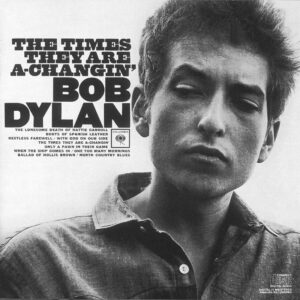
1964, 6/10
Dylan focused on a very specific aspect of his musical vocabulary for his third album, stretching the pessimistic protest songs from Freewheelin’, like ‘A Hard Rain’s a-Gonna Fall’ into a full-length statement. The result is a stark album that doesn’t capture Dylan at his most musical. Strong outtakes like ‘Percy’s Song’, which was later covered magnificently by Fairport Convention, and ‘Lay Down Your Weary Tune’, which The Byrds later recorded, are more musically interesting than the songs that were included on the completed album. Songs like ‘Ballad of Hollis Brown’ and ‘The Lonesome Death of Hattie Carroll’ are ultra-serious and not particularly tuneful, and a whole album of them is exhausting.
The album’s most famous song is the title track, which has always felt like an uninspired retread of ‘Blowin’ in the Wind’ – additionally, Dylan’s version has been diluted by insipid versions by terminally uncool acts like The Seekers and Simon and Garfunkel. Dylan recycles the melody of the title track for ‘One Too Many Mornings’, a song which shines in electric versions like on Live 1966, but which isn’t terribly exciting here. My favourite song is ‘When The Ship Comes In’, inspired by an incident when an unkempt Dylan was refused entry to his hotel room, while like ‘Girl From The North Country’ on the previous record, ‘Boots of Spanish Leather’ is another pretty melody inspired by English folk music.
Dylan succeeded in creating the album he was trying to make with The Times They Are a-Changin’, a pessimistic collection of protest songs, but fortunately he’d be more musically interesting on his next record.
Another Side of Bob Dylan

1964, 7.5/10
Another Side of Bob Dylan is Dylan’s last guitar and vocal album from his early folk records and was recorded in a single session. After the dour Times, Dylan’s sense of humour is back on songs like ‘Motorpsycho Nitemare’. The political “finger-pointing” songs are gone entirely and Dylan rejects his previous status as a protest singer on ‘My Back Pages’. Dylan’s songwriting is becoming more sophisticated and outgrowing the simple acoustic format. This combination of the more expansive melodies and simple arrangements highlights Dylan’s vocal limitations, like his high notes in the opener ‘All I Really Want To Do’. Many of these songs are better heard in cover versions – several turned up on Byrds records, most notably ‘My Back Pages’.
Another Side is one of Dylan’s lesser-known 1960s albums, perhaps because it doesn’t have a single iconic song – ‘My Back Pages’ is the best known, but The Byrds’ version is more celebrated. But there’s a lot of strong material here – my favourite is the downbeat closer ‘It Ain’t Me, Babe’, with its nihilistic attitude to love, and it suits the simple acoustic presentation. I’ve always enjoyed the gentle ‘To Ramona’, while Dylan plays piano of ‘Black Crow Blues’. Among all the well-written songs, there’s one tough listen; ‘Ballad in Plain D’ is an account of Dylan’s breakup with Suze Rotolo, a vehicle for self-expression and a turgid eight minutes.
There are many strong songs here, but Another Side of Bob Dylan is an album that feels weaker than the sum of its parts – put a full band on some of these songs, and drop ‘Ballad in Plain D’, and it would be one of Dylan’s best records.
Bringing It All Back Home
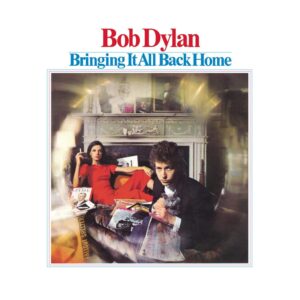
1965, 8.5/10
Bringing It All Back Home is a candidate for the most groundbreaking album in the history of rock music, combining the energy of rock and roll with sophisticated, introspective lyrics, expanding the scope of popular music. A couple of years earlier, Dylan was the golden child of protest folk; he’d largely abandoned the genre lyrically on Another Side of Bob Dylan, and now he abandoned it musically, utilising a rock band on the album’s first side.
The album’s divided into two clear sides – the first side sees Dylan accompanied by a band. They’re not as sharp as his later accompanists, and they’re best on the relaxed grooves of ‘She Belongs To Me’ and the excellent ‘Love Minus Zero/No Limit’, but tracks like ‘Maggie’s Farm’ could arguably use some more firepower. Opening track ‘Subterranean Homesick Blues’ works fine with its minimal arrangement; it was accompanied by the first significant music video, while the song’s beat poetry inspired lyrics and delivery were another boundary broken. “You don’t need a weatherman to know which way the wind blows” is perhaps Dylan’s most quoted line.
The second side is almost entirely solo, with four longer compositions. If you’re accustomed to The Byrds’ version, Dylan’s original of ‘Mr Tambourine Man’ is in 2/4 time and has extra verses. I always assumed it was a drug reference, but it’s literally about producer Tom Wilson owning a very large tambourine. The seven and a half minutes of ‘It’s All Right, Ma (I’m Only Bleeding)’ are hypnotic, and it’s full of quotable lines (“He not busy being born is busy dying”). ‘Gates of Eden’ can be a tough listen, and four lengthy acoustic tracks in a row can drag, but it’s one of Dylan’s most intriguing LP sides.
For all of the historical significance of Bringing It All Back Home, it’s overshadowed by its two successors. But there are a lot of essential songs here, and it’s a worthy first installment in Dylan’s renowned mid-1960s trilogy of electric albums.
Highway 61 Revisited
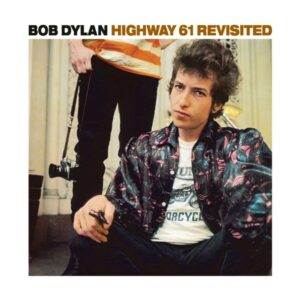
1965, 9/10
Dylan was in full electric mode on his second album of 1965. He recruited a classier backing band, featuring musicians like Al Kooper and young guitarist Mike Bloomfield, and kick-started the record with the classic rock chestnut ‘Like A Rolling Stone’. If Dylan sounded ornery on his earlier records, here he’s an amphetamine-fuelled whirlwind of disdainful wordplay.
Highway 61 Revisited isn’t all intense – ‘It Takes a Lot to Laugh, It Takes a Train to Cry’ is pleasant, relaxed blues, while ‘Queen Jane Approximately’ is pretty and sweet. The banging piano of ‘Ballad of a Thin Man’ features Dylan’s wordplay at its most surreal, with lines like “give me some milk or else go home,” although my favourite line is from ‘Tombstone Blues’; “The sun’s not yellow, it’s chicken”.
But the album has its most notable songs as bookends – ‘Like A Rolling Stone’ is a disdainful put-down of a socialite and features Al Kooper’s organ playing – unrehearsed, his organ changes are a beat behind the rest of the band, giving the song a distinctive sound. ‘Desolation Row’ is the epic closer, featuring some of Dylan’s most vivid imagery with Nashville guitarist Charlie McCoy supplying the background colour. If there’s a weakness, some of the tracks are a little long, and it doesn’t quite have the stylistic range of Blonde on Blonde.
In the mid-1960s Dylan was at the height of his powers and at the height of his cultural significance – his next record was even better.
Blonde on Blonde

1966, 10/10
Dylan had started using The Hawks as his live band, a largely Canadian bar band who had previously backed Ronnie Hawkins and who would later become famous as The Band. They recorded the non-album single ‘Can You Please Crawl Out Your Window?’, but attempts to record an entire album were difficult, and the only song captured was ‘One of Us Must Know (Sooner or Later)’. Dylan instead recorded in Nashville, bringing Al Kooper and Hawks guitarist Robbie Robertson along with him. At the peak of his creativity, Dylan recorded rock and roll’s first double album.
Blonde on Blonde is a logical successor to Highway 61 Revisited, expanding that record’s parameters – the blues songs are more aggressive, with Robertson’s lead guitar, while the slower songs are prettier. It’s less verbose and more musical – closer ‘Sad-Eyed Lady of the Lowlands’ arguably isn’t quite as lyrically exhilarating as ‘Desolation Row’, but it’s more musically satisfying.
Unlike almost every double album that’s followed in its wake, Blonde on Blonde barely has a dispensable track. Dylan’s perhaps a little over-reliant on blues, but the blues songs are memorable – due to Robertson’s lead guitar or hilarious lyrics like ‘Leopard Skin Pillbox Hat’. For all the charm of highlights like the opening Salvation Army band style ‘Rainy Day Women #12 & 35’ and the prettiness of ‘One of Us Must Know (Sooner or Later)’, the real stunners are the slow songs. ‘Visions of Johanna’ is slow and meditative, one of Dylan’s most accomplished yet mysterious songs. ‘Sad-Eyed Lady of the Lowlands’ is a melodic tribute to Dylan’s new bride, Sara Lownds.
One of the most intriguing, yet musically satisfying, albums in the classic rock canon, Blonde on Blonde captures Dylan at the height of his considerable powers.
The Bootleg Series Vol. 4: Bob Dylan Live 1966, The “Royal Albert Hall” Concert

1998, 10/10
Dylan’s switch to rock and roll was disconcerting to his audience, who preferred him to keep producing folk anthems such as ‘Blowin’ in the Wind’ and ‘The Times They Are A Changing’. He and his band were constantly heckled at concerts, and the records that he produced during the period were sometimes harangued by critics: the sleeve notes report that one critic dismissed ‘Like A Rolling Stone’ as “sub-standard Dylan” with “monotonous melody line and expressionless intoning….going over to the electronic enemy.” Live 1966 was recorded at the height of the controversy; just before ‘Like A Rolling Stone’, a member of the audience shouts “Judas” at Dylan. Dylan’s famously backed by most of the musicians who went on to form The Band – while Levon Helm sat the tour out, tiring of the controversy, Rick Danko, Robbie Robertson, Richard Manuel, and Garth Hudson are all present.
The two discs of the live album document the different halves of the show (which was actually in Manchester, the original bootleg was misnamed so the official release continues the tradition): the first is a solo acoustic set, while the second is an electric set with most of The Band backing Dylan. The first disc is very focused and intimate, with some excellent vocal performances as Dylan tackles epics ‘Desolation Row’ and ‘Visions of Johanna’. The second disc is even better with The Band providing fire and intensity; with guitarist Robbie Robertson’s aggressive leads. As well as highlights from recent electric albums Highway 61 Revisited and Blonde on Blonde, Dylan reaches back into his catalogue for electrified versions of ‘Baby Let Me Follow You Down’ and ‘One Too Many Mornings’.
Albert Hall is a great live album, given extra impetus by its historical significance.
John Wesley Harding
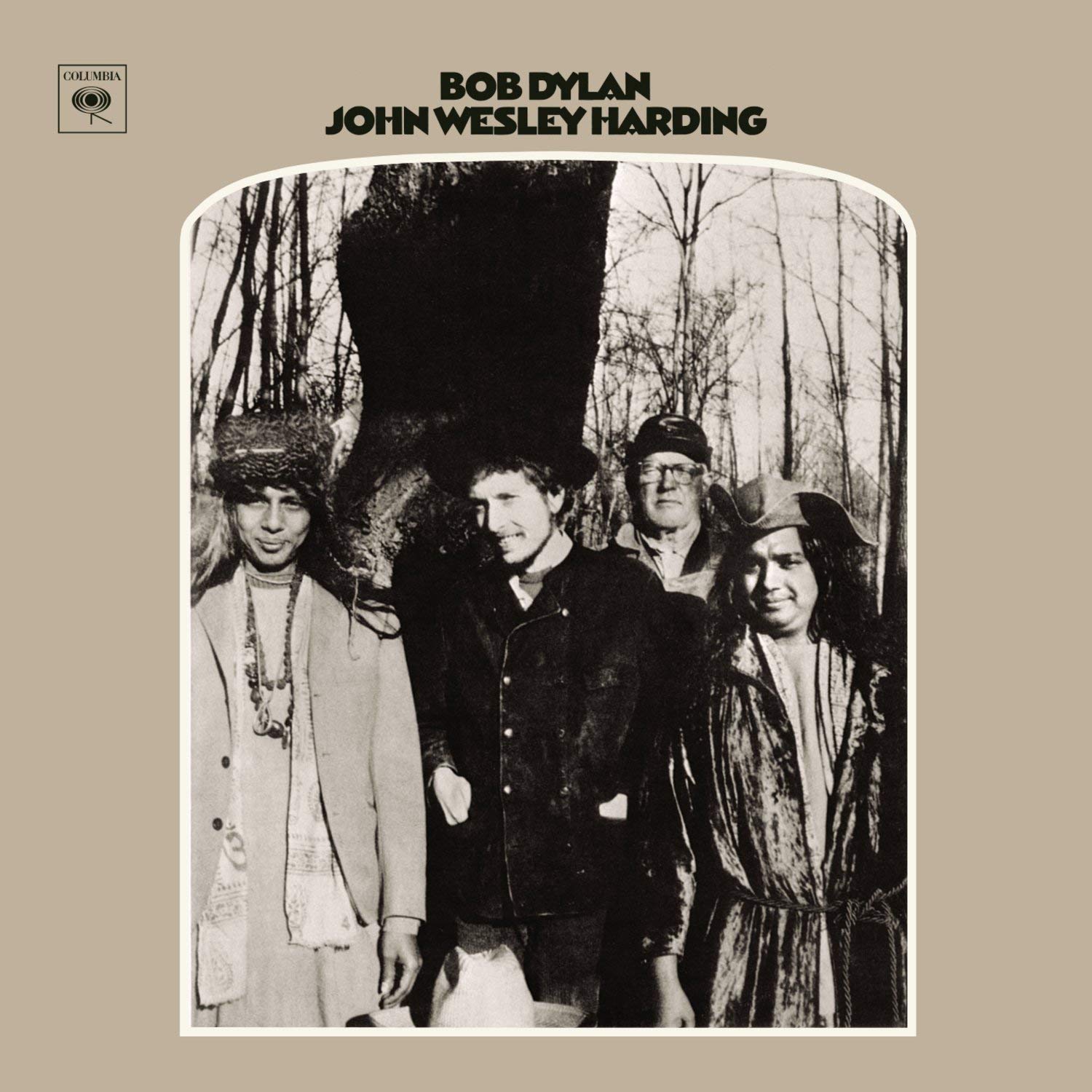
1967, 9/10
Bob Dylan’s 1966 motorcycle accident was a catalyst for a major change in lifestyle – he retreated from the limelight, embraced family life, and moved to Woodstock. While he was at the forefront of stretching the parameters of popular music in 1965 and 1966, his 1967 music was markedly different, acoustic and inspired by Hank Williams and The Bible. Despite the changes, 1967 was his most prolific year as a writer, recording dozens of demos with The Band as The Basement Tapes, which weren’t released until 1975, and then recording John Wesley Harding in Nashville.
After the rich textures of Blonde on Blonde, John Wesley Harding is stark, with Dylan’s writing newly economical and mostly centred on a trio, just Dylan with a rhythm section of Kenny Buttrey and Charlie McCoy. it was originally planned for The Band’s Robbie Robertson and Garth Hudson to overdub parts but it was decided to let the original recordings stand, a decision at odds with the rich, psychedelic albums of the era, like Sgt. Peppers and Surrealistic Pillow.
The minimalist treatment suits these songs – while they may initially appear slight, they’re some of Dylan’s best work. The most well-known song is ‘All Along the Watchtower’, taken from the book of Isaiah in The Bible; it was an unsuccessful single but Jimi Hendrix’s psychedelic cover placed it in the annals of classic rock. Songs like ‘I Pity the Poor Immigrant’ are melodically rooted in British folk. After a bleak set of morality tales like ‘The Ballad Of Frankie Lee And Judas Priest’, John Wesley Harding ends with two warmer, country flavoured songs, notably ‘I’ll Be Your Baby Tonight’..
It’s hard to know what Dylan’s audience would have made of John Wesley Harding at the time – it’s almost a 180-degree reversal from the musical richness and verbal verbosity of Blonde on Blonde. But in retrospect, it stands as one of Dylan’s best records.
Nashville Skyline
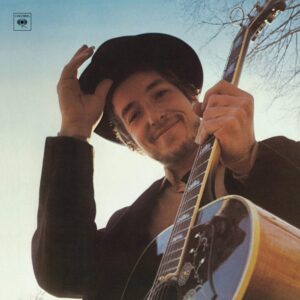
1969, 6.5/10
Van Morrison made a trio of tuneful, satisfied albums that are known his domestic trilogy, and which reflect his happy settled life in Woodstock. Nashville Skyline, which marginally pre-dates the Morrison records, is very much in the same vein, a tuneful, but often slight record of country tunes. While John Wesley Harding offered a unique take on country, with the minimal arrangements and Biblical, foreboding lyrics, Nashville Skyline is lyrically conventional, sticking to common country themes. There’s little to identify it as a Dylan album, and even his voice is different – Dylan quit smoking temporarily, and his voice here is a pleasant country croon.
Aside from the reworking on ‘Girl From The North Country’ with Johnny Cash, there are only two songs that have been identified as definitely written before the recording sessions. Perhaps not coincidentally, they’re the two strongest tracks .’Lay Lady Lay’ is the best-known song, filled with alliteration, (“lay lady lay”, “big brass bed”). My favourite interpretation of the excellent, introspective lead single ‘I Threw It All Away’ is that it concerns Dylan’s relationship with his muse. But elsewhere the material does sound a little like a writer struggling for inspiration, and making songs up in the studio – pieces like the endearingly silly wordplay of ‘Peggy Day’ are fun, but not among Dylan’s best.
Nashville Skyline is likeable but at the same time, it’s surprisingly dispensable for a 1960s Dylan album.
Self Portrait

1970, not rated
I’ve never heard this – it’s a double album largely made up of covers, and in some quarters it was viewed as a mechanism for Dylan to shed his mystique. Greil Marcus started his Rolling Stone review with “What is this shit?”, while Dylan described it as “Well, it wouldn’t have held up as a single album—then it really would’ve been bad, you know. I mean, if you’re gonna put a lot of crap on it, you might as well load it up!”
New Morning

1970, 7.5/10
New Morning opens with the sweet country of ‘If Not For You’, which gives a misleading impression that it’s a retread of Nashville Skyline. But New Morning treads deeper, stranger waters. The catalyst for the album was Dylan’s involvement in a play by Archibald MacLeish, a musical version of The Devil and Daniel Webster titled Scratch. At least three songs were written for the play before Dylan withdrew from the project, and they were the catalyst for the rest of the album. Dylan’s often on piano for these songs, and, as on John Wesley Harding, there’s plenty of religious flavour; the record ends with the Jewish prayer of ‘Father of Night’.
New Morning is notable for some of Dylan’s most unusual material; in particular, ‘If Dogs Run Free’ is most of his bizarre moments, with Dylan reciting beat jazz with scat singing in the background. There’s also the short ‘Winterlude’, which rhymes the title phrase with “dude”, and where it’s difficult to ascertain whether Dylan’s serious. But there are plenty of excellent, and prettier than usual, songs – ‘If Not For You’ is a breezy opener, while ‘Sign on the Window’ is a beautiful composition based around Dylan’s piano.
While it’s flawed, New Morning is a consistently interesting record that’s somewhat overlooked in Dylan’s extensive catalogue.
Pat Garrett and Billy the Kid
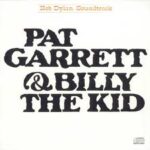
1973, not rated
Dylan’s soundtrack for the 1973 Sam Peckinpah western was largely instrumental, but also features one of Dylan’s best-known songs; ‘Knockin’ On Heaven’s Door’.
Dylan
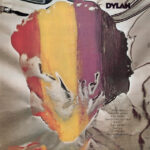
1973, not rated
Dylan left Columbia for Asylum, and Columbia responded with a collection of outtakes from Self Portrait and New Morning. Dylan consists entirely of covers and is often regarded as a career nadir.
Planet Waves

1974, 6.5/10
Dylan joined Asylum Records and reunited with The Band for his fourteenth studio album. While there have subsequently been other releases with Dylan and The Band – The Basement Tapes and Live 1966 were both recorded earlier – this was the first full album available with the pairing, and perhaps the hype contributed it to it becoming Dylan’s first number one album.
The material is often personal and mellow, so there’s less outlet for The Band’s ensemble playing than you might expect, while Dylan purposefully limited rehearsal times to give the album a raw sound. It’s less intricately arranged and disciplined than The Band’s own records, with Robbie Robertson’s guitar leads as the dominant instrument.
‘Tough Mama’ is the piece that utilises The Band’s prowess best; Helm and Danko lay down a funky groove, while Hudson’s organ and Robertson’s guitar duel for attention. The best-known song is ‘Forever Young’, with an unusually straightforward sentiment from Dylan but also one of his prettiest tunes. Elsewhere there’s some nice material like ‘Hazel’, and some surprisingly straightforward and emotionally open material from Dylan like ‘You Angel You’.
Planet Waves has some strong moments, but it’s not one of Dylan’s best and it’s thoroughly overshadowed by his next two records.
Blood on the Tracks: The New York Sessions
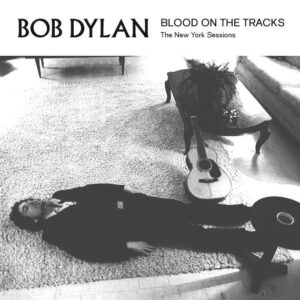
Recorded 1974 (bootleg), 9/10
In 1974, Dylan started taking art classes in New York. Dylan later said in an interview: “I went home after that first day and my wife never did understand me ever since that day. That’s when our marriage started breaking up. She never knew what I was talking about, what I was thinking about, and I couldn’t possibly explain it.” Blood on the Tracks was recorded after the Dylans separated; while Dylan’s denied the album is autobiographical, Jakob Dylan, leader of The Wallflowers, describes the lyrics of the album as “my parents talking”.
Dylan initially recorded the album in New York, and again attempted the spontaneous approach to recording that he’d used on Planet Waves. Much of the New York Sessions are Dylan on acoustic guitar backed only with Deliverance bass player Tony Brown. It’s minimal, but it suits the solemn and articulate songs.
Song for song, Blood on the Tracks covers the stages of grief of a relationship ending – there’s the anger of ‘Idiot Wind’, the sad resignation of ‘You’re Gonna Make Me Lonesome When You Go’, and the gracious acceptance of ‘If You See Her, Say Hello’ and ‘Buckets of Rain’.
This wasn’t the version of Blood on the Tracks that was eventually released (read below for details), but I prefer it to the finished version. Until recently it was only available on bootleg, but the New York sessions have recently been released as More Blood, More Tracks.
Blood on the Tracks
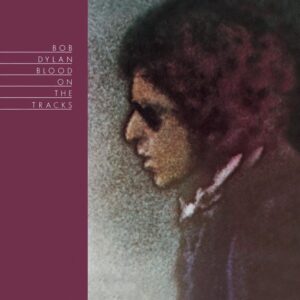
1975, 8.5/10
When Dylan played a test acetate of Blood on the Tracks to his brother, he was persuaded that the arrangements were too stark for the album to succeed commercially, and he re-recorded five of the tracks in Minnesota. Blood on the Tracks is among Dylan’s best collections of songs, but the final version is marred by some tacky arrangements.
The prime culprit is ‘Lily, Rosemary and the Jack of Hearts’ – it’s an intriguing set of lyrics, an ambiguous tale of two women and a bank robbery, but Dylan’s accompanied by a jaunty country rhythm section with a repetitive bass line that outstays its welcome on a nine-minute song. On the other hand, the excellent opener ‘Tangled Up In Blue’ benefits from the bright, fuller arrangement, but overall the original album is stronger to my ears. There are also notable lyric changes between some of the New York Sessions and the eventual release, particularly prominent on ‘Tangled Up In Blue’, where the second to last verse is markedly different.
It’s still one of best Dylan’s albums either way, but the painfully repetitive rhythm section on ‘Lily….’ makes the originally recorded version of Blood on the Tracks preferable.
The Basement Tapes

1975, 7.5/10
After his motorcycle accident in 1966, Dylan and his young family moved to upstate New York. In Woodstock he linked up with most of his backing band from his 1966 tour, who would later become The Band – Levon Helm wouldn’t re-join the group until after the Dylan sessions. The music that Dylan and The Band played in the basement of Big Pink was the opposite of the aggressive rock and roll from their 1966 tour – they started playing covers, re-engaging with traditional American music, and Dylan’s originals were in the same vein. The Basement Tapes are notable for Dylan’s unguarded persona – while he was hiding behind imagery in his mid-1960s peak, he’s having fun here, making songs up as he goes along.
The Big Pink sessions were bootlegged as Great White Wonder, and many of the songs emerged in versions from other artists, but the results of the basement recording weren’t officially released until 1975. Robbie Robertson took charge of the project and was the dominant voice in selecting the songs for the double album. There’s been some justifiable criticism of Robertson’s selections – strong pieces like ‘Quinn the Eskimo (The Mighty Quinn)’, ‘I’m Not There’, and ‘I Shall Be Released’ were left off, while 8 of the 24 songs don’t feature Dylan There’s also conjecture that some of The Band songs were recorded later than the original summer 1967 sessions. In particular, ‘Bessie Smith’ is the standout of The Band songs, but it’s from a later period, and it’s an odd fit for this record.
Otherwise, the non-Dylan material drags down the album – Manuel and Robertson hadn’t fully developed as writers yet, relying on blues songs. A regular twelve-song version of solely Dylan songs would have been much stronger, as there’s plenty of very good Dylan material. The soaring, mournful ‘Tears of Rage’ was written with The Band’s Richard Manuel, while the jaunty ‘You Ain’t Going Nowhere’ had already surfaced on The Byrds’ Sweetheart of the Rodeo. ‘Goin’ To Acapulco’ is world-weary and mournful, while the more down-home songs like ‘Apple Suckling Tree’ are fun.
There are lots of strong Dylan compositions on The Basement Tapes, and it’s fun to hear him in a more relaxed mode, but a more succinct version, focused on Dylan’s songs, would be even stronger.
Desire

1976, 8/10
Dylan was riding a peak of confidence in the mid-1970s, with the successful releases of Blood on the Tracks and The Basement Tapes. He’d watched a performance by the emergent Patti Smith, and admiring her tight band had formed the Rolling Thunder Revue. Desire was released in between legs of the tour and features many of the same musicians. Unusually for Dylan, Desire features the contributions of several distinctive collaborators – Scarlet Rivera plays exotic violin while Jacques Levy wrote most of the lyrics for the record.
The most controversial piece on Desire is ‘Joey’ – it’s apparently an unreasonably positive portrayal of gangster Joey Gallo. Unaware of the context, it’s just not a very good song, dragging over eleven minutes. The other biographical piece, ‘Hurricane’ about the boxer Rubin Carter is widely loved, providing the album with a confident start. My favourite piece though is ‘Isis’, which rides a simple four-chord sequence for its engrossing story. Backing vocalist Emmylou Harris shines on ‘One More Cup Of Coffee’ and ‘Mozambique’, while the closing ‘Sara’ is a pretty paean to his estranged wife – I love the couplet “I stayed up for days in the Chelsea Hotel/writing ‘Sad Eyed Lady Of the Lowlands’ for you.”
Desire was one of Dylan’s highest-selling albums, and it’s a confident and colourful effort. It’s also the end of an era – I’m not sure that Dylan’s made such an accomplished album since.
Masterpieces
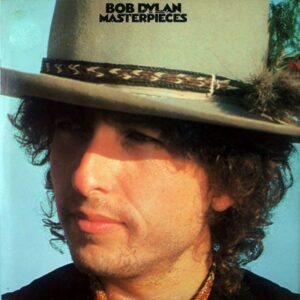
1978, 8.5/10
This compilation was released only in Asia and Australasia and it’s now out of print, but it was my first Dylan album. In hindsight, after Desire was a perfect time to release a career-spanning retrospective – it marked the end of Dylan’s prime phase. Spanning 36 tracks and including rarities like ‘Rita Mae’ and ‘George Jackson’ and non-album singles like ‘Positively Fourth Street’ and ‘Can You Please Crawl Out Your Window?’, Masterpieces was one of the first box sets.
Even 36 tracks aren’t enough to properly cover Dylan’s first 15 years, and presumably because of space restrictions, significant long tracks like ‘Desolation Row’ and ‘Sad Eyed Lady of the Lowlands’ are omitted. Planet Waves, released on Asylum, is skipped, and some songs are represented on live versions – I enjoy the intense Hard Rain take on ‘Idiot Wind’, but would rather have the studio version of ‘Like A Rolling Stone’.
Despite all these quibbles, Masterpieces is essentially one great song after another. It’s worth seeking out the non-album tracks, but Dylan’s catalogue is so vast and rich that even this three-CD set isn’t a sufficient one-stop shopping solution.
Street-Legal

1978, not rated
I’ve never heard this – it’s regarded as one of Dylan’s lesser albums from the 1970s.
Slow Train Coming

1979, 5.5/10
Dylan became a born-again Christian in the late 1970s and released a trilogy of religious albums. Slow Train Coming is the first and the best-received of the trilogy. Dylan’s musical palette has shifted along with his beliefs – I’ve always found it interesting that Christian artists believe that God prefers smooth music. While Dylan often preferred off the cuff recording sessions for albums like Planet Waves, Slow Train Coming is slick and carefully rehearsed. The band includes Muscle Shoals keyboardist Barry Beckett, three female backing singers, and Mark Knopfler and Pick Withers from Dire Straits.
The smooth sound of Slow Train Coming works as long as the material is good, and the first side is tangibly stronger than the second. The record’s strongest song is the opener ‘Gotta Serve Somebody’, Dylan reciting a list over a smooth groove. On the other hand, the reggae-tinged, quasi-children’s song ‘Man Gave Names to All the Animals’ is one of Dylan’s most awkward pieces.
It’s interesting to hear Dylan operating in a different idiom, but Slow Train Coming is dispensable unless you’re a Dylan fanatic.
1980-1993 Albums
I’m skipping a bunch of records here:
- Saved (1980)
- Shot of Love (1981)
- Infidels (1983)
- Empire Burlesque (1985)
- Knocked Out Loaded (1986)
- Down in the Groove (1988)
- Oh Mercy (1989)
- Under the Red Sky (1990)
- Good as I Been to You (1992)
- World Gone Wrong (1993)
Of the above, I want to come back and cover Oh Mercy some time – it’s certainly the most acclaimed album on the list, and I’ve enjoyed the songs I’ve heard from it. Otherwise, I don’t think I’m missing out on too much, although ‘Every Grain Of Sand’ from Shot of Love is a lovely song.
Time Out Of Mind

1997, 7/10
Dylan hadn’t released an album of original material since 1990, and expectations weren’t high. The album’s often associated with Dylan’s health scare in 1997 – Dylan was hospitalised with a near-fatal infection, and given the pensive nature of songs like ‘Not Dark Yet’, it was assumed to be inspired by his health issues. But in fact, the record was completed before his July hospitalisation. Time Out Of Mind is produced by Eno disciple Daniel Lanois, who gives Dylan a rich, atmospheric backdrop to his meditative songs, giving them gravitas. It’s a great sounding record, and one that I’m arguably underrating, but at the same time, I listen to Time Out Of Mind much less often than his key 1960s and 1970s record.
Among all of the dignified blues songs, there are two pieces that break the mould. ‘Highlands’, the closer, is the longest piece that Dylan’s recorded on a studio album. It’s fun and engaging, with Dylan rambling about eggs and waitresses over a blues sequence in a way that’s reminiscent of his mid-1960s heyday. ‘Make You Feel My Love’ is a surprisingly straightforward sentiment from Dylan, and it’s become something of a standard, covered by Adele, Billy Joel, and Garth Brooks. Otherwise, individual songs like ‘Cold Irons Bound’ and ‘Not Dark Yet’ are strong, but the lack of diversity and length makes them blend together.
Time Out Of Mind won a Grammy for album of the year, and it’s a very respectable late-period effort, but for me it’s nowhere near Dylan’s best.
“Love and Theft”
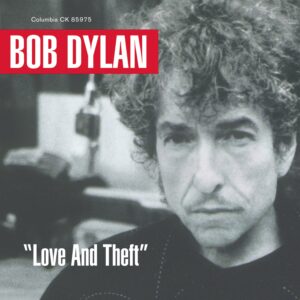
2001, 7/10
Love and Theft continues Dylan’s late-career resurgence, and I’ve always thought of it as a companion piece to Time Out Of Mind. They’re both blues-based albums, but while Time Out Of Mind is a refined, studio product, Love and Theft sounds like it was recorded in a dusty studio in the 1940s, with Dylan (using the pseudonym Jack Frost) in the producer’s chair and utilising his live band. It’s not purely a blues album; Love and Theft is rooted in other traditional American music, like country and swing. Oddly, some listeners pointed out similarities between some of Dylan’s lyrics and passages from Junichi Saga’s book Confessions of a Yakuza.
The first half is the more upbeat, with a rawer sound. My favourite from the half is ‘Mississippi’ – it was originally intended for Time Out Of Mind, and was recorded by Sheryl Crow before Dylan’s version emerged. It’s a memorable melody, and the chorus line (“Only one thing I did wrong/Stayed in Mississippi a day too long”) is cutely reminiscent of the vintage Dylan of ‘Stuck Inside of Mobile with the Memphis Blues Again’. My other favourite musical moment of the album is the violin riff that drives the old-timey ‘Floater’. Dylan also mines old-time American music for pieces like ‘Po’ Boy’ and ‘Sugar Baby’, and that’s he able to do so in such an authentic way speaks volumes for his love of this music.
Like Time Out Of Mind, I’m arguably underrating this record – it’s a remarkable accomplishment for someone forty years into his career; I just rarely feel like listening to it when he has so many excellent earlier albums.
I’m Not There

2008, 7.5/10
The 2008 Bob Dylan biopic I’m Not There was notable for portraying Dylan using six different actors, representing six different stages and aspects of his career. Cate Blanchett’s take on the wired Dylan of the mid-1960s was particularly noteworthy.
The soundtrack’s an interesting collection of Dylan covers – it’s impressive how wide a net it draws over Dylan’s career, skipping over the best-known tracks like ‘Blowin’ In The Wind’ and ‘Like A Rolling Stone’, and mining lesser-known albums like Saved and Empire Burlesque’. The artists featured are generally guitar-wielding and rootsy; there are plenty of representatives from the indie class of the decade, but also contemporaries of Dylan like Ramblin’ Jack Elliott, Willie Nelson, and Roger McGuinn. A super-group with Lee Ranaldo, Tom Verlaine, Nels Cline, Steve Shelley, and members of Dylan’s road band perform on a number of tracks, while Dylan himself appears on the terrific title track, rescued from the Basement Tapes sessions.
There’s an eclectic selection of artists here, and favourites probably depend on which artists you’re already familiar with. Surprisingly, my favourite track is John Doe, from X, with a loving rendition of ‘Pressing On’ from Saved. My Morning Jacket’s Jim James delivers a soaring version of ‘Goin’ To Acapulco’, while acts like Sufjan Stevens and The Hold Steady bend Dylan’s compositions to their own signature sounds.
The movie is a more interesting portrait of Dylan than the soundtrack is, and I’d recommend seeing it first, but I’m Not There is a loving trawl through Dylan’s back catalogue.
Ten Favourite Bob Dylan Songs
Sad-Eyed Lady of the Lowlands
Don’t Think Twice, It’s Alright
Tangled Up In Blue
Love Minus Zero/No Limit
Subterranean Homesick Blues
Like A Rolling Stone
Visions of Johanna
Isis
Can You Please Crawl Out Your Window?
Shelter From The Storm
Back to 1960s album reviews…..
17 Comments
Leave a Reply
Related Pages
About
Aphoristic Album Reviews is almost entirely written by one person. It features album reviews and blog posts across a growing spectrum of popular music.
Review Pages
Read about the discographies of musical acts from the 1960s to the present day. Browse this site's review archives or enjoy these random selections:
Blog Posts
I add new blog posts to this website every week. Browse the archives or enjoy these random selections:

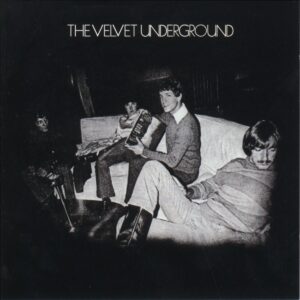
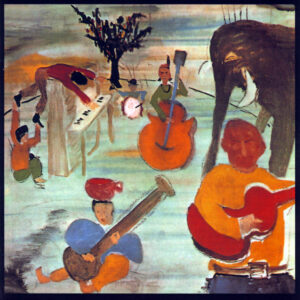


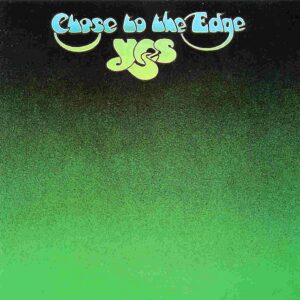







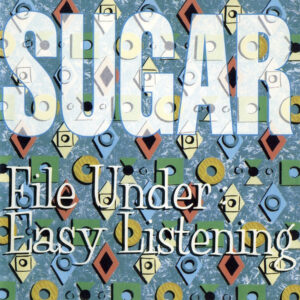

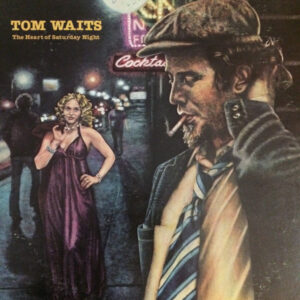


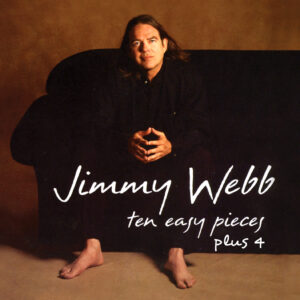
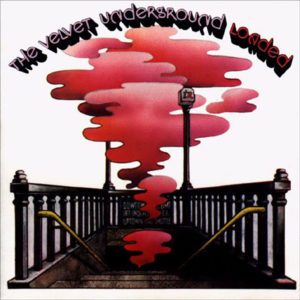





I’d be inclined to suggest Infidels and World Gone Wrong are also worth a listen. While the latter is another covers album it has some strong takes on there including Blood In My Eyes while Infidels ditches the religious stuff and has a good overall vibe
Do you like Oh Mercy as well? I guess I should have a second run at Dylan sometime. I’ve always enjoyed ‘Jokerman’, so I am interested in Infidels.
I do. ‘Most of the Time’ is in my Dylan Top 10
Top 10
Knocking on Heaven’s Door
If not for you
Lay Lady Lay
Changing of the Guard
Like a Rolling Stone
Tangled Up In Blue
I Want You
It Ain’t Me Babe
Mighty Quinn
Watching the river flow
Mozambique
You need to listen to Infidels as well as Oh, Mercy. You are missing out on some great songs.
Those sound like good suggestions – I need to go through a few more Dylan records sometime.
IMOP you can’t go wrong with Bob Dylan with the EXCEPTION OF RAINY-DAY WOMEN 12 and 35. a real stinker with that same hellacious beat of They’re Coming to Take Me Away.
How about Wiggle Wiggle?
Infidels is a classic album and well worth a listen as a back to his best after the last two born again disasters.
Thanks for writing in! I should probably go back and cover 1980s Dylan sometime – I used to have a copy of Saved so I already know that one (and agree it’s not very good).
Street Legal is my favourite Dylan album…..you should dig it out
It would be a logical one to cover sometime – I need to come back and have another run at Dylan.
Ummm… you say that Bob named himself after “Welsh poet Robert Thomas”?
Oops – good spotting. I think I was conflating Dylan Thomas and Robert Frost in my head. Fixed now
The key albums you overlooked, imo, are Street Legal (dismissed even by Dylan, but I love it for the pure rush it gives, even if some lyrics begin to sound very patriarchal these days), Shot Of Love.. a brilliant album that was blasted by critics who had lost all objectivity because of their rejection of Dylan’s Judeo-Christian worldview and lyrics. Apart from a dirge-like, though compassionate “Lenny Bruce”, all of the tracks are great and the gospel backup singers fill & elevate the sound of this album. Ironically, it was the media who were being dogmatic and obsessed in their rejection of this fine album. “Caribbean Winds” & “Angelina” were the missing diamonds & later versions of the album included the former.
Finally, no overview of Dylan records should overlook Infidels. It is a great record but imo not as strong as Shot Of Love. “I & I” is an outstanding song & the album has a great feel to it. Personally, I love “Neighbourhood Bully” as a grinding blues/rock song that really flies but the politics around it are best left as food for thought. As Dylan himself quotes, in “Jokerman”, “fools rush in where angels fear to tread”.
Thanks for your interesting reviews 🙂
Thanks for reading. I should probably go and fill in the gaps sometime. Do you like Slow Train Coming?
Correction.. the track that was added later was the very decent “The Groom’s still waiting at the Alter”, not “Caribbean Winds” as I claimed earlier (which is on a fantastic bootleg compilation I have, hence the confusion).